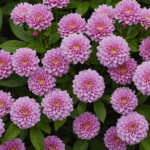Whiteflies are common pests that can cause significant damage to gardens and plants. In this article, we will discuss how to identify whiteflies, the damage they can cause, and effective methods for controlling and preventing infestations.
Identifying Whiteflies
Whiteflies, also known as aleurodes, are small insects that resemble tiny white flies. They belong to the hemiptera order and are typically no larger than 3 mm. Whiteflies are recognizable by their powdery texture and two pairs of wings. When disturbed, they will quickly fly away in large swarms. There are many species of whiteflies, with over 1,000 known varieties worldwide.
Understanding Whiteflies’ Behavior
Whiteflies prefer warm conditions, with activity increasing when temperatures reach around 15°C. In temperate climates, they are most active from late spring to early autumn. Whiteflies thrive in dry conditions and dislike humidity, making them more common in enclosed and poorly ventilated spaces. Their reproduction rate is high, with a female whitefly capable of laying over 500 eggs during a single generation. These eggs are typically laid on the undersides of plant leaves and hatch within 1 to 3 weeks. Whitefly larvae remain stationary as they undergo their transformation, which can take anywhere from 3 to 10 weeks. The adult lifespan is short, lasting around 1 month on average.
Damages Caused by Whiteflies
Whiteflies can cause significant damage to various plants, including vegetables, fruits, ornamental plants, and more. They feed on plant sap by piercing the plants with their rostrums, weakening the plants and sometimes causing them to wither and die. Additionally, whiteflies secrete a sticky substance known as honeydew, which promotes the growth of black sooty mold. This mold can further damage the plants and negatively impact their overall health. Whiteflies can also transmit diseases to plants through their feeding, providing entry points for various pathogens. Early warning signs of whitefly infestations include stunted growth, yellowing leaves, and wilting fruits.
Preventing Whitefly Infestations
Regular observation is crucial for preventing whitefly infestations, as it allows for early detection and prompt action. Keeping plants in optimal growing conditions, such as providing sufficient sunlight, watering properly, and maintaining good air circulation, helps make them less susceptible to pests. Some gardeners also use preventive treatments such as plant-based sprays or decoctions to limit the number of whiteflies. While the efficacy of these natural solutions is not scientifically proven, they may help strengthen the plants’ natural defenses. If growing plants indoors, regular ventilation and maintaining proper humidity levels can deter whiteflies. Outdoor relocation during the warmer months is also beneficial for plants that are not susceptible to fungal diseases like mildew. Isolating affected plants promptly can prevent the spread of whiteflies and potential infestations.
Natural Control Methods for Whiteflies
Using chemical insecticides is not recommended for controlling whiteflies, as they can be ineffective and harmful to both human health and the environment. Instead, consider using natural insecticides like a homemade soap spray made from diluted black soap and vegetable oil. This mixture suffocates and kills whitefly larvae and adults. However, it’s important to note that even natural insecticides are non-selective and may harm beneficial insects. Therefore, use them sparingly. Biological control methods, such as introducing predatory insects like Encarsia formosa (micro-wasps), Macrolophus pigmaeus (green capsid bugs), or Delphastus pusillus (black ladybugs), can help reduce whitefly populations. These natural predators attack whitefly larvae and eggs, providing an effective and environmentally friendly control method. Promoting a biodiverse garden by avoiding the use of chemical pesticides and creating a favorable habitat for beneficial insects is another way to maintain a natural balance and control whitefly populations.
Additional Natural Solutions
Some gardeners recommend planting odoriferous plants, such as marigolds, dill, or basil, near susceptible crops to repel whiteflies. However, the effectiveness of this method can vary. There are also commercially available solutions made from essential oils, such as Pelargonium X asperum (Geranium rosat). Diluted drops of these oils can be applied to affected leaves to repel whiteflies.
Whiteflies can be a significant pest in gardens, causing damage to various plants. Identifying whiteflies early and implementing preventive measures can help minimize infestations. Natural control methods, such as using homemade soap sprays or introducing beneficial predators, offer effective and environmentally friendly ways to combat whitefly populations. By maintaining a healthy garden ecosystem and avoiding the use of harmful chemicals, you can effectively control whiteflies while still promoting plant health and biodiversity.



